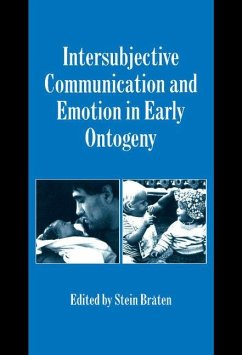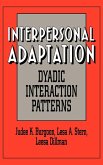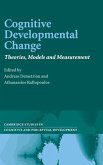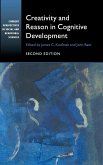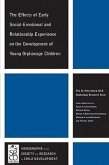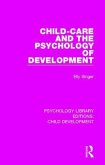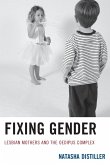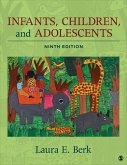Stein Bråten (ed.)
Intersubjective Communication and Emotion in Early Ontogeny
Herausgeber: Braten, Stein; Manstead, Antony; Oatley, Keith
Stein Bråten (ed.)
Intersubjective Communication and Emotion in Early Ontogeny
Herausgeber: Braten, Stein; Manstead, Antony; Oatley, Keith
- Gebundenes Buch
- Merkliste
- Auf die Merkliste
- Bewerten Bewerten
- Teilen
- Produkt teilen
- Produkterinnerung
- Produkterinnerung
A comprehensive 1999 volume examining concept of intersubjectivity in emotion and communication of the very young.
Andere Kunden interessierten sich auch für
![Interpersonal Adaptation Interpersonal Adaptation]() Judee K. BurgoonInterpersonal Adaptation129,99 €
Judee K. BurgoonInterpersonal Adaptation129,99 €![Cognitive Developmental Change Cognitive Developmental Change]() Andreas Demetriou / Athanassios Raftopoulos (eds.)Cognitive Developmental Change145,99 €
Andreas Demetriou / Athanassios Raftopoulos (eds.)Cognitive Developmental Change145,99 €![Creativity and Reason in Cognitive Development Creativity and Reason in Cognitive Development]() Creativity and Reason in Cognitive Development133,99 €
Creativity and Reason in Cognitive Development133,99 €![The Effects of Early Social-Emotional and Relationship Experience on the Development of Young Orphanage Children The Effects of Early Social-Emotional and Relationship Experience on the Development of Young Orphanage Children]() The St Petersburg-Usa Orphanage Research TeamThe Effects of Early Social-Emotional and Relationship Experience on the Development of Young Orphanage Children57,99 €
The St Petersburg-Usa Orphanage Research TeamThe Effects of Early Social-Emotional and Relationship Experience on the Development of Young Orphanage Children57,99 €![Child-Care and the Psychology of Development Child-Care and the Psychology of Development]() Elly SingerChild-Care and the Psychology of Development153,99 €
Elly SingerChild-Care and the Psychology of Development153,99 €![Fixing Gender Fixing Gender]() Natasha DistillerFixing Gender64,99 €
Natasha DistillerFixing Gender64,99 €![Infants, Children, and Adolescents Infants, Children, and Adolescents]() Laura E BerkInfants, Children, and Adolescents183,99 €
Laura E BerkInfants, Children, and Adolescents183,99 €-
-
-
A comprehensive 1999 volume examining concept of intersubjectivity in emotion and communication of the very young.
Hinweis: Dieser Artikel kann nur an eine deutsche Lieferadresse ausgeliefert werden.
Hinweis: Dieser Artikel kann nur an eine deutsche Lieferadresse ausgeliefert werden.
Produktdetails
- Produktdetails
- Verlag: Cambridge University Press
- Seitenzahl: 472
- Erscheinungstermin: 15. März 2012
- Englisch
- Abmessung: 235mm x 157mm x 32mm
- Gewicht: 911g
- ISBN-13: 9780521622578
- ISBN-10: 0521622573
- Artikelnr.: 24691734
- Herstellerkennzeichnung
- Libri GmbH
- Europaallee 1
- 36244 Bad Hersfeld
- gpsr@libri.de
- Verlag: Cambridge University Press
- Seitenzahl: 472
- Erscheinungstermin: 15. März 2012
- Englisch
- Abmessung: 235mm x 157mm x 32mm
- Gewicht: 911g
- ISBN-13: 9780521622578
- ISBN-10: 0521622573
- Artikelnr.: 24691734
- Herstellerkennzeichnung
- Libri GmbH
- Europaallee 1
- 36244 Bad Hersfeld
- gpsr@libri.de
List of figures; List of tables; List of contributors; Preface;
Introduction; Part I. Intersubjective Attunement in Human Infancy and
Impairment in Autism: 1. The concept and foundations of infant
intersubjectivity Colwyn Trevarthen; 2. Infant intersubjectivity:
broadening the dialogue to include imitation, identity and intention Andrew
N. Meltzoff and M. Keith Moore; 3. Neonatal imitation in the
intersubjective companion space Giannis Kugiumutzakis; 4. Imitation in
neonates, in older infants and in children with autism: feedback to theory
Mikael Heimann; 5. Infant learning by altercentric participation: the
reverse of egocentric observation in autism Stein Bråten; Part II.
Companionship and Emotional Responsiveness in Early Childhood: 6.
Contributions of experimental and clinical perturbations of mother-infant
communication to the understanding of infant intersubjectivity Lynne
Murray; 7. Empathy and its origins in early development Ross A. Thompson;
8. Siblings, emotion and the development of understanding Judy Dunn; 9. The
company children keep: suggestive evidence from cultural studies Carolyn
Pope Edwards; Part III. Imitation, Emotion and Understanding in Primate
Communication: 10. Ontogeny, communication and parent-offspring
relationships Patrick Bateson; 11. Social-experiential contributions to
imitation and emotion in chimpanzees Kim A. Bard; 12. Imitation: the
contributions of priming and program-level copying Richard W. Byrne; 13. Do
concepts of intersubjectivity apply to non-human primates? Juan Carlos
Gomez; 14. Imitation and the reading of other minds: perspectives from the
study of autism, normal children and non-human primates Andrew Whiten and
Julie D. Brown; Part IV. Intersubjective Attunement and Emotion in Language
Learning and Use: 15. The intersubjective foundations of thought R. Peter
Hobson; 16. Language, culture and intersubjectivity: the creation of shared
perception Patricia K. Kuhl; 17. Intersubjectivity in early language
learning and use Nameera Akhtar and Michael Tomasello; 18. Fictional
absorption: emotional response to make-believe Paul L. Harris; 19.
Intersubjective attunement and linguistically mediated meaning in discourse
Ragnar Rommetveit; 20. Intersubjective communion and understanding:
development and perturbation Stein Bråten; References; Indexes.
Introduction; Part I. Intersubjective Attunement in Human Infancy and
Impairment in Autism: 1. The concept and foundations of infant
intersubjectivity Colwyn Trevarthen; 2. Infant intersubjectivity:
broadening the dialogue to include imitation, identity and intention Andrew
N. Meltzoff and M. Keith Moore; 3. Neonatal imitation in the
intersubjective companion space Giannis Kugiumutzakis; 4. Imitation in
neonates, in older infants and in children with autism: feedback to theory
Mikael Heimann; 5. Infant learning by altercentric participation: the
reverse of egocentric observation in autism Stein Bråten; Part II.
Companionship and Emotional Responsiveness in Early Childhood: 6.
Contributions of experimental and clinical perturbations of mother-infant
communication to the understanding of infant intersubjectivity Lynne
Murray; 7. Empathy and its origins in early development Ross A. Thompson;
8. Siblings, emotion and the development of understanding Judy Dunn; 9. The
company children keep: suggestive evidence from cultural studies Carolyn
Pope Edwards; Part III. Imitation, Emotion and Understanding in Primate
Communication: 10. Ontogeny, communication and parent-offspring
relationships Patrick Bateson; 11. Social-experiential contributions to
imitation and emotion in chimpanzees Kim A. Bard; 12. Imitation: the
contributions of priming and program-level copying Richard W. Byrne; 13. Do
concepts of intersubjectivity apply to non-human primates? Juan Carlos
Gomez; 14. Imitation and the reading of other minds: perspectives from the
study of autism, normal children and non-human primates Andrew Whiten and
Julie D. Brown; Part IV. Intersubjective Attunement and Emotion in Language
Learning and Use: 15. The intersubjective foundations of thought R. Peter
Hobson; 16. Language, culture and intersubjectivity: the creation of shared
perception Patricia K. Kuhl; 17. Intersubjectivity in early language
learning and use Nameera Akhtar and Michael Tomasello; 18. Fictional
absorption: emotional response to make-believe Paul L. Harris; 19.
Intersubjective attunement and linguistically mediated meaning in discourse
Ragnar Rommetveit; 20. Intersubjective communion and understanding:
development and perturbation Stein Bråten; References; Indexes.
List of figures; List of tables; List of contributors; Preface;
Introduction; Part I. Intersubjective Attunement in Human Infancy and
Impairment in Autism: 1. The concept and foundations of infant
intersubjectivity Colwyn Trevarthen; 2. Infant intersubjectivity:
broadening the dialogue to include imitation, identity and intention Andrew
N. Meltzoff and M. Keith Moore; 3. Neonatal imitation in the
intersubjective companion space Giannis Kugiumutzakis; 4. Imitation in
neonates, in older infants and in children with autism: feedback to theory
Mikael Heimann; 5. Infant learning by altercentric participation: the
reverse of egocentric observation in autism Stein Bråten; Part II.
Companionship and Emotional Responsiveness in Early Childhood: 6.
Contributions of experimental and clinical perturbations of mother-infant
communication to the understanding of infant intersubjectivity Lynne
Murray; 7. Empathy and its origins in early development Ross A. Thompson;
8. Siblings, emotion and the development of understanding Judy Dunn; 9. The
company children keep: suggestive evidence from cultural studies Carolyn
Pope Edwards; Part III. Imitation, Emotion and Understanding in Primate
Communication: 10. Ontogeny, communication and parent-offspring
relationships Patrick Bateson; 11. Social-experiential contributions to
imitation and emotion in chimpanzees Kim A. Bard; 12. Imitation: the
contributions of priming and program-level copying Richard W. Byrne; 13. Do
concepts of intersubjectivity apply to non-human primates? Juan Carlos
Gomez; 14. Imitation and the reading of other minds: perspectives from the
study of autism, normal children and non-human primates Andrew Whiten and
Julie D. Brown; Part IV. Intersubjective Attunement and Emotion in Language
Learning and Use: 15. The intersubjective foundations of thought R. Peter
Hobson; 16. Language, culture and intersubjectivity: the creation of shared
perception Patricia K. Kuhl; 17. Intersubjectivity in early language
learning and use Nameera Akhtar and Michael Tomasello; 18. Fictional
absorption: emotional response to make-believe Paul L. Harris; 19.
Intersubjective attunement and linguistically mediated meaning in discourse
Ragnar Rommetveit; 20. Intersubjective communion and understanding:
development and perturbation Stein Bråten; References; Indexes.
Introduction; Part I. Intersubjective Attunement in Human Infancy and
Impairment in Autism: 1. The concept and foundations of infant
intersubjectivity Colwyn Trevarthen; 2. Infant intersubjectivity:
broadening the dialogue to include imitation, identity and intention Andrew
N. Meltzoff and M. Keith Moore; 3. Neonatal imitation in the
intersubjective companion space Giannis Kugiumutzakis; 4. Imitation in
neonates, in older infants and in children with autism: feedback to theory
Mikael Heimann; 5. Infant learning by altercentric participation: the
reverse of egocentric observation in autism Stein Bråten; Part II.
Companionship and Emotional Responsiveness in Early Childhood: 6.
Contributions of experimental and clinical perturbations of mother-infant
communication to the understanding of infant intersubjectivity Lynne
Murray; 7. Empathy and its origins in early development Ross A. Thompson;
8. Siblings, emotion and the development of understanding Judy Dunn; 9. The
company children keep: suggestive evidence from cultural studies Carolyn
Pope Edwards; Part III. Imitation, Emotion and Understanding in Primate
Communication: 10. Ontogeny, communication and parent-offspring
relationships Patrick Bateson; 11. Social-experiential contributions to
imitation and emotion in chimpanzees Kim A. Bard; 12. Imitation: the
contributions of priming and program-level copying Richard W. Byrne; 13. Do
concepts of intersubjectivity apply to non-human primates? Juan Carlos
Gomez; 14. Imitation and the reading of other minds: perspectives from the
study of autism, normal children and non-human primates Andrew Whiten and
Julie D. Brown; Part IV. Intersubjective Attunement and Emotion in Language
Learning and Use: 15. The intersubjective foundations of thought R. Peter
Hobson; 16. Language, culture and intersubjectivity: the creation of shared
perception Patricia K. Kuhl; 17. Intersubjectivity in early language
learning and use Nameera Akhtar and Michael Tomasello; 18. Fictional
absorption: emotional response to make-believe Paul L. Harris; 19.
Intersubjective attunement and linguistically mediated meaning in discourse
Ragnar Rommetveit; 20. Intersubjective communion and understanding:
development and perturbation Stein Bråten; References; Indexes.

